|
P 1 |
P 2 |
F 1 |
F 2 |
BC 1 |
BC 2 |
| Mean |
20.5 |
40.2 |
28.9 |
32.1 |
25.2 |
35.4 |
| Variance |
10.1 |
13.2 |
7.0 |
52.3 |
35.1 |
56.5 |
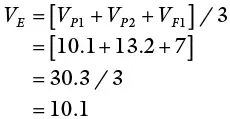
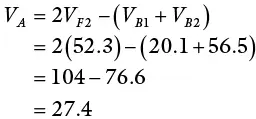

Broad sense heritability
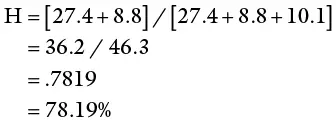
Narrow sense heritability
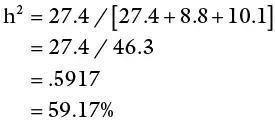
Other methods of estimation
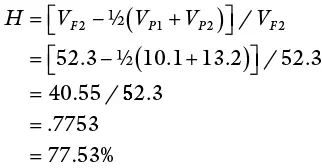
(The estimate is very close to that obtained by using the previous formula.)
Parent–Offspring RegressionThe type of offspring determines if the estimate would be broad sense or narrow sense. This method is based on several assumptions: the trait of interest has diploid Mendelian inheritance; the population from which the parents originated is random‐mated; the population is in linkage equilibrium (or no linkage among loci controlling the trait); parents are non‐inbred; no environmental correlation between the performance of parents and offspring.The parent–offspring method of heritability is relatively straightforward. First, the parent and offspring means are obtained. Cross products of the paired values are used to compute the covariance. A regression of offspring on mid‐parent is then calculated. Heritability in the narrow sense is obtained as follows:where bop is the regression of offspring on mid‐parent, and VA and VP = additive variance, and phenotypic variance, respectively.However, if only one parent is known or relevant (e.g. a polycross):and h2 = 2bop
Applications of heritability
Heritability estimates are useful for breeding quantitative traits. The major applications of heritability are:
1 To determine whether a trait would benefit from breeding. If especially the narrow sense heritability for a trait is high, it indicates that the use of plant breeding methods will likely be successful in improving the trait of interest.
2 To determine the most effective selection strategy to use in a breeding program. Breeding methods that use selection based on phenotype are effective when heritability is high for the trait of interest.
3 To predict gain from selection. Response to selection depends on heritability. A high heritability would likely result in high response to selection to advance the population in the desired direction of change.
Evaluating parental germplasm
A useful application of heritability is in evaluating the germplasm assembled for a breeding project to determine if there is sufficient genetic variation for successful improvement to be pursued. A replicated trial of the available germplasm is conducted and analyzed by ANOVA as follows:
| Source |
df |
EMS |
| Replication |
r−1 |
|
| Genotypes |
g−1 |
σ 2+ rσ 2g |
| Error |
(r−1)(g−1) |
σ 2 |
From the analysis, heritability may be calculated as

Whether the estimate is heritability in the narrow or broad sense depends on the nature of the genotypes. Pure lines or inbred lines would yield additive type of variance, making the estimate narrow sense. Segregating population would make the estimate broad sense.
4.2.11 Response to selection in breeding
The focus of this section is on the response to selection( genetic gainor genetic advance). After generating variability, the next task for the breeder is the critical one of advancing the population through selection.
Selection, in essence, entails discriminating among genetic variation (heterogeneous population) to identify and choose a number of individuals to establish the next generation. The consequence of this is differential reproduction of genotypes in the population such that gene frequencies are altered, and subsequently, the genotypic and phenotypic values of the targeted traits. Even though artificial selection is essentially directional, the concept of “complete” or “pure” artificial selection is an abstraction because, invariably, before the breeder gets a chance to select plants of interest, some amount of natural selection would have already been imposed.
The breeder hopes, by selecting from a mixed population, that superior individuals (with high genetic potential) will be advanced, and consequently change the population mean of the trait in a positive way in the next generation. The breeder needs to have a clear objective. The trait to be improved needs to be clearly defined. Characters controlled by major genes are usually easy to select. However, polygenic characters, being genetically and biologically complex, present a considerable challenge to the breeder.
The response to selection (R) is the difference between the mean phenotypic value of the offspring of the selected parents and the whole of the parental generation before selection. The response to selection is simply the change of population mean between generations following selection. Similarly, the selection differential (S)is the mean phenotypic value of the individuals selected as parents expressed as a deviation from the population mean (i.e. from the mean phenotypic value of all the individuals in the parental generation before selection). Response to selection is related to heritability by the following equation:

Prediction of response in one generation – genetic advance due to selection
The genetic advance achieved through selection depends on three factors:
1 The total variation (phenotypic) in the population in which selection will be conducted.
2 Heritability of the target character.
3 Selection pressure to be imposed by the plant breeder (i.e. the proportion of the population that is selected for the next generation).
A large phenotypic variance would provide the breeder a wide range of variability from which to select. Even when the heritability of the trait of interest is very high, genetic advance would be small without a large amount of phenotypic variation ( Figure 4.3). When the heritability is high, selecting and advancing only the top few performers is likely to produce a greater genetic advance than selecting many moderate performers. However, such a high selection pressure would occur at the expense of a rapid loss in variation. When heritability is low, the breeder should impose a lower selection pressure in order to advance as many high‐potential genotypes as possible.
Читать дальше




















